12-03: Rational Functions
Rational function: Obtained through the division of polynomials
Sometimes there’s an x in the numerator
There is always an x in the denominator
No passing through asymptotes, no right angles, no curving back on yourself
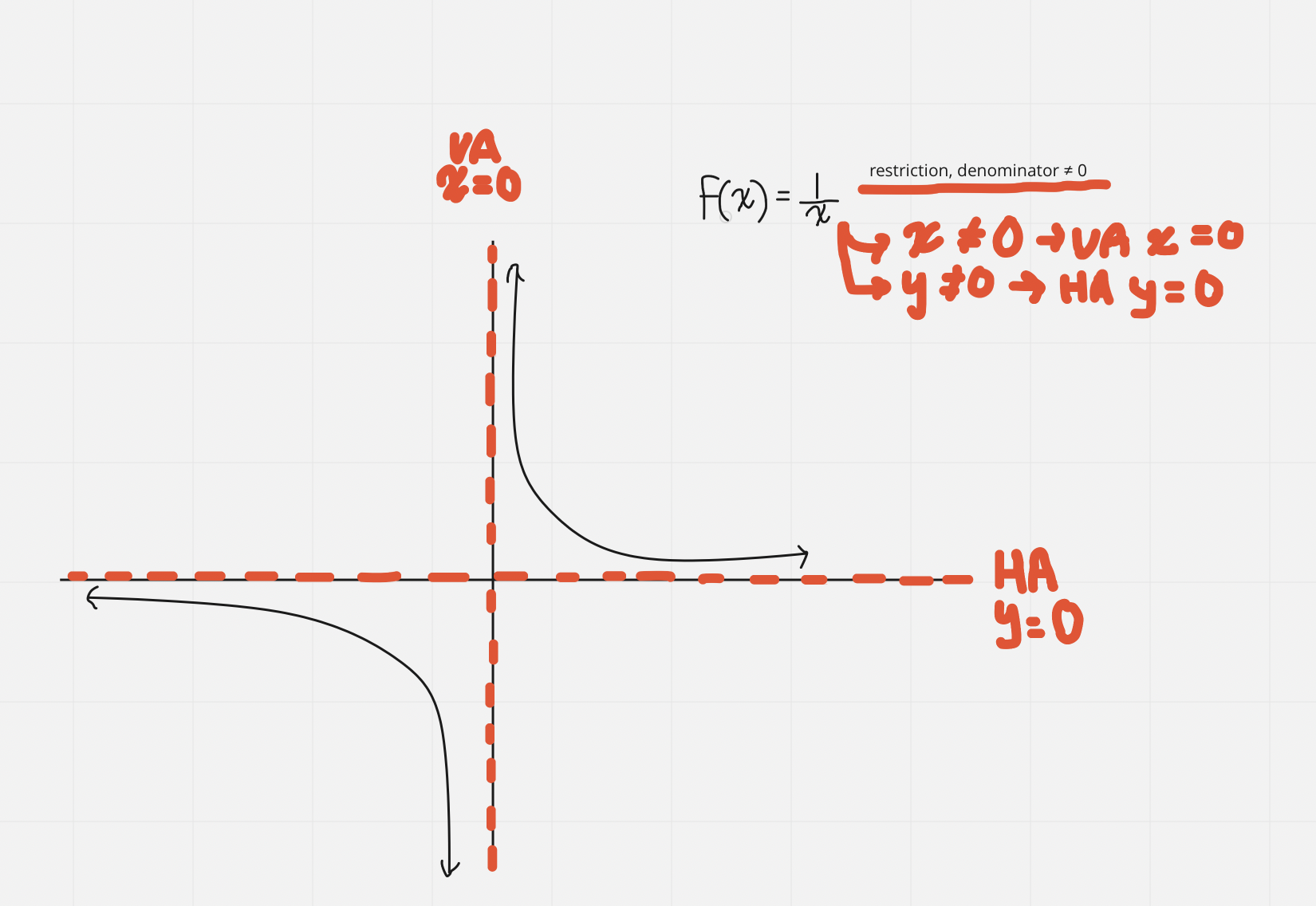
Horizontal asymptotes are less strict than vertical asymptotes
Behaviour Near Asymptote
When graphing rational functions, it is useful to know what is happening as we approach both the vertical & horizontal asymptotes
For Vertical Asymptotes (VA):
In order to see the behaviour as we approach the vertical asymptote, we want to know what is happening to the y values as we approach the VA from both the left and right sides
For Horizontal Asymptotes (HA):
In order to know the behaviour as we approach the HA, we want to know what is happening to the y values as x→ ∞ and as y → ∞
Notation
a little + at the top of the number means to the right of, a little - to the top of the number means to the left of (think of it as a number line)
Reciprocal of a Linear Function
General formula:
Degree of numerator is equal to the degree of the denominator
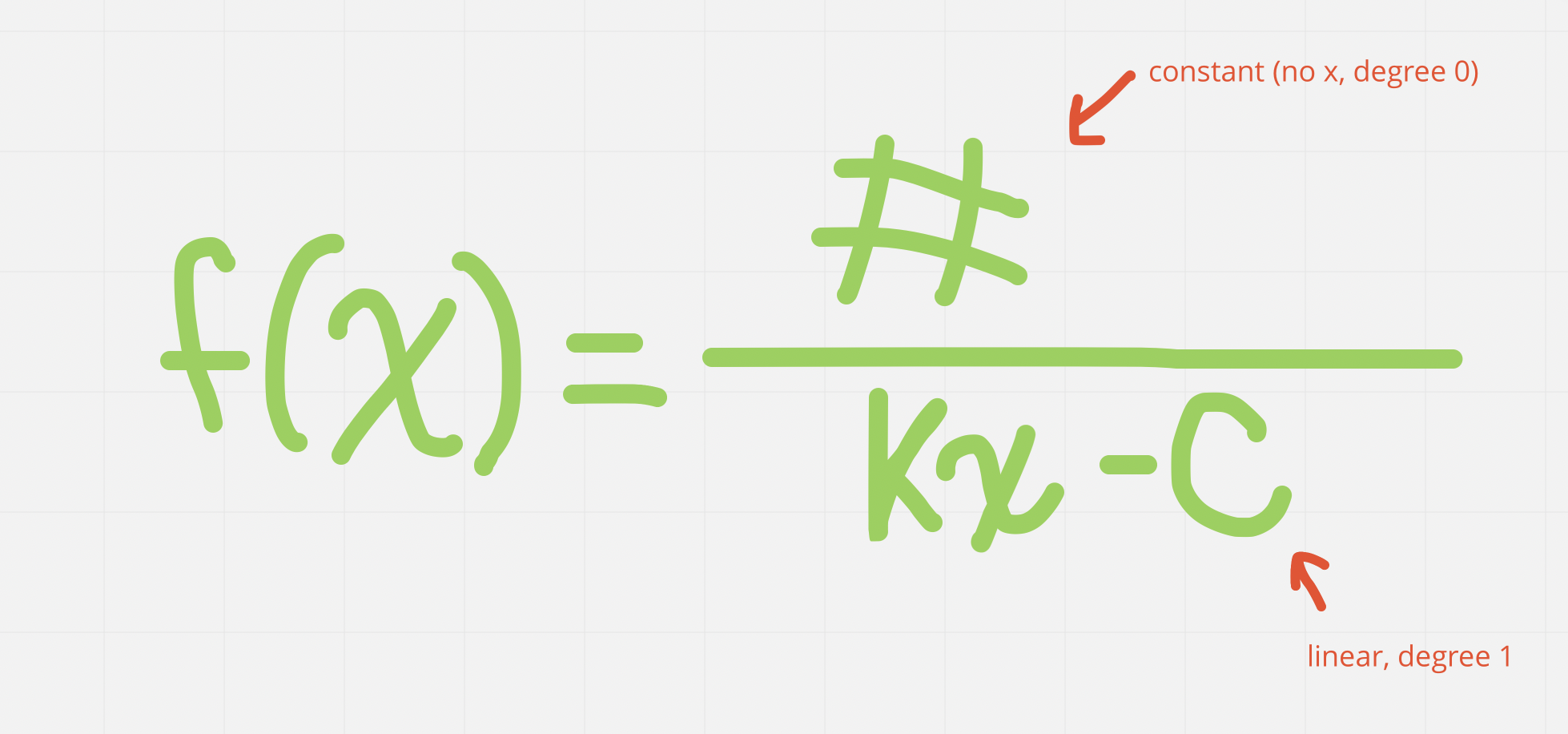
Procedure for the Reciprocal of a Linear Function
Find VA, make the denominator = to 0 and solve | Find HA, with reciprocals of linear functions, your HA will be y=0 (rule: no x in numerator, HA y=0) | Find behaviour asymptotes (both VA and HA). Use headings x→ and y→ and from there, you put your VA⁻⁻ and VA⁺ (this is the behaviour near VA) and -∞ and ∞ (this is behaviour near HA). You will sub in test values from here. The test values you will use for the VA will be one decimal to the left (for VA⁻⁻) and one decimal to the right (for VA⁺); the test values you use for HA: for the -∞ you put -100 and for ∞ you put 100. Sub these into the equation. From there, determine what it approaches and where it is positioned based on its value, and whether its positive or negative | Sketch: fill out the sketch while going through the process of finding all of the highlighted attributes. Draw VA and HA in. Behaviours from the chart can be drawn as arrows on the graph (according to result from chart) |
|---|---|---|---|
Find x intercept: if there is no x in the numerator, there is no x intercept | Find y intercept: sub 0 in for x (f(0)) and solve | Domain and range: Domain ≠ VA, Range ≠ HA. Use interval notation to write your domain and range statements. | Analyze slopes: slope analysis is a rate of change. Increasing: above HA, decreasing: below HA. Look at the graph to determine whether the slope is positive (/) or negative (\) |
Reciprocal of a Quadratic Function
General formula:
Degree of the denominator is greater than the degree of the numerator
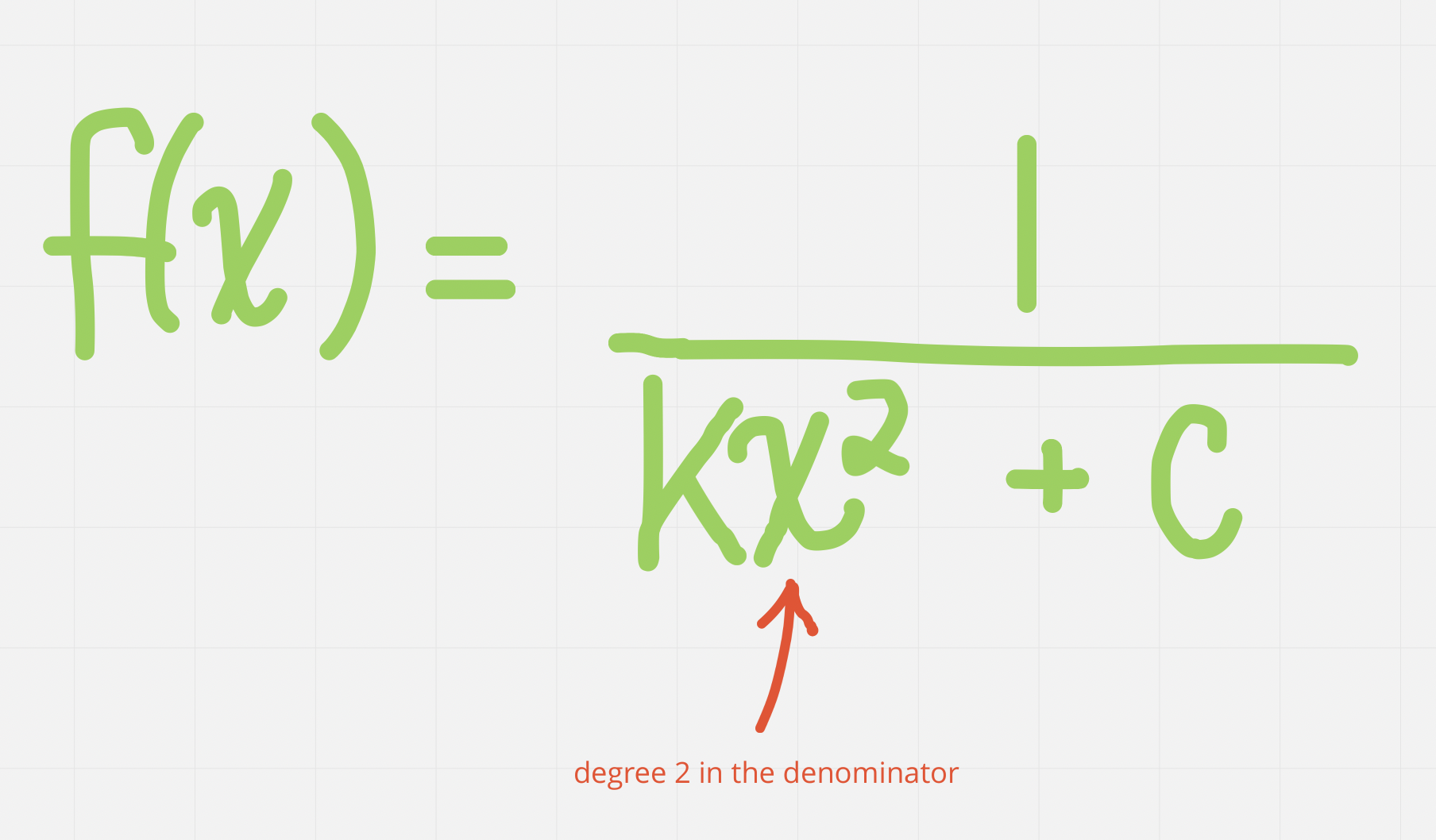
A reciprocal function’s key features:
Asymptotes, HA and VA
Intercepts, x int and y int
Domain and range
End behaviour/behaviour near asymptotes
Positive/negative intervals
Slope, positive/negative; increasing/decreasing
Process
Factor the denominator before operating
You will have 2 VAs
Same process as with reciprocals of linear functions
There will be a vertex and the quadratic reciprocal function is almost opened up (if you think of linear reciprocal function as folded up)
Find VA, make the denominator = to 0 and solve | Find HA, with reciprocals of linear functions, your HA will be y=0 (rule: no x in numerator, HA y=0) | Find behaviour asymptotes (both VA and HA). Use headings x→ and y→ and from there, you put your VA⁻⁻ and VA⁺ (this is the behaviour near VA) and -∞ and ∞ (this is behaviour near HA). You will sub in test values from here. The test values you will use for the VA will be one decimal to the left (for VA⁻⁻) and one decimal to the right (for VA⁺); the test values you use for HA: for the -∞ you put -100 and for ∞ you put 100. Sub these into the equation. From there, determine what it approaches and where it is positioned based on its value, and whether its positive or negative | Sketch: fill out the sketch while going through the process of finding all of the highlighted attributes. Draw VA and HA in. Behaviours from the chart can be drawn as arrows on the graph (according to result from chart) |
|---|---|---|---|
Find x intercept: if there is no x in the numerator, there is no x intercept | Find y intercept: sub 0 in for y (f(0)) and solve | Domain and range: Domain ≠ VA, Range ≠ HA. Use interval notation to write your domain and range statements. Include the vertex with a [ ] in interval notation, and beware of the areas that are skipped. U (unions) go in between brackets. | Analyze slopes: slope analysis is a rate of change. Increasing: above HA, decreasing: below HA. Look at the graph to determine whether the slope is positive (/) or negative (\) |
Find the vertex:
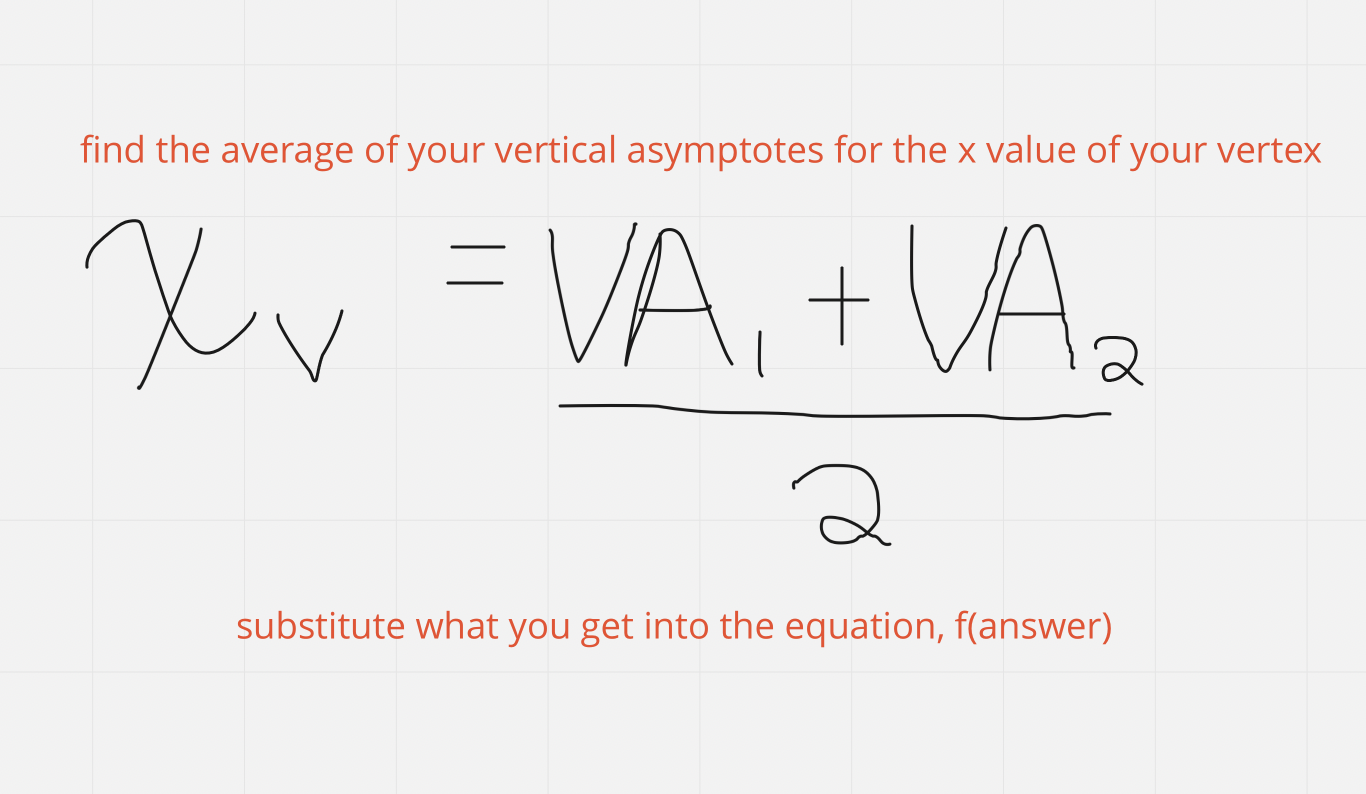
Rational Functions
General formula:

There is an x in both the numerator and denominator now, still equal in degree though
Procedure
Find x intercept: solve numerator = 0 | Find VA: solve denominator = 0 | Find behaviour asymptotes (both VA and HA). Use headings x→ and y→ and from there, you put your VA⁻⁻ and VA⁺ (this is the behaviour near VA) and -∞ and ∞ (this is behaviour near HA). You will sub in test values from here. The test values you will use for the VA will be one decimal to the left (for VA⁻⁻) and one decimal to the right (for VA⁺); the test values you use for HA: for the -∞ you put -100 and for ∞ you put 100. Sub these into the equation. From there, determine what it approaches and where it is positioned based on its value, and whether its positive or negative |
|---|---|---|
Find y intercept: substitute x=0 into the equation, OR use the shortcut: y int=b/a | Find HA: y=a/c | Sketch: fill out the sketch while going through the process of finding all of the highlighted attributes. Draw VA and HA in. Behaviours from the chart can be drawn as arrows on the graph (according to result from chart) |
Domain: cannot equal VA, skip over asymptote | Range: cannot equal HA, skip over asymptote | Analyze slopes: slope analysis is a rate of change. Increasing: above HA, decreasing: below HA. Look at the graph to determine whether the slope is positive (/) or negative (\) |
Rational Equations and Inequalities
Solving Rational Equations
Clear your fractions: multiply, expand, solve
Make one side = to another
State restrictions, denominator ≠ 0
Factor first
Solving Rational Inequalities (<,>,≤,≥ are inequality signs)
Do not clear fractions
Rearrange for 0 on one side
Simplify to a single fraction: factor, common denominator
Make an interval table
Numerator → x intercept
Denominator → vertical asymptote
Making an Interval Table
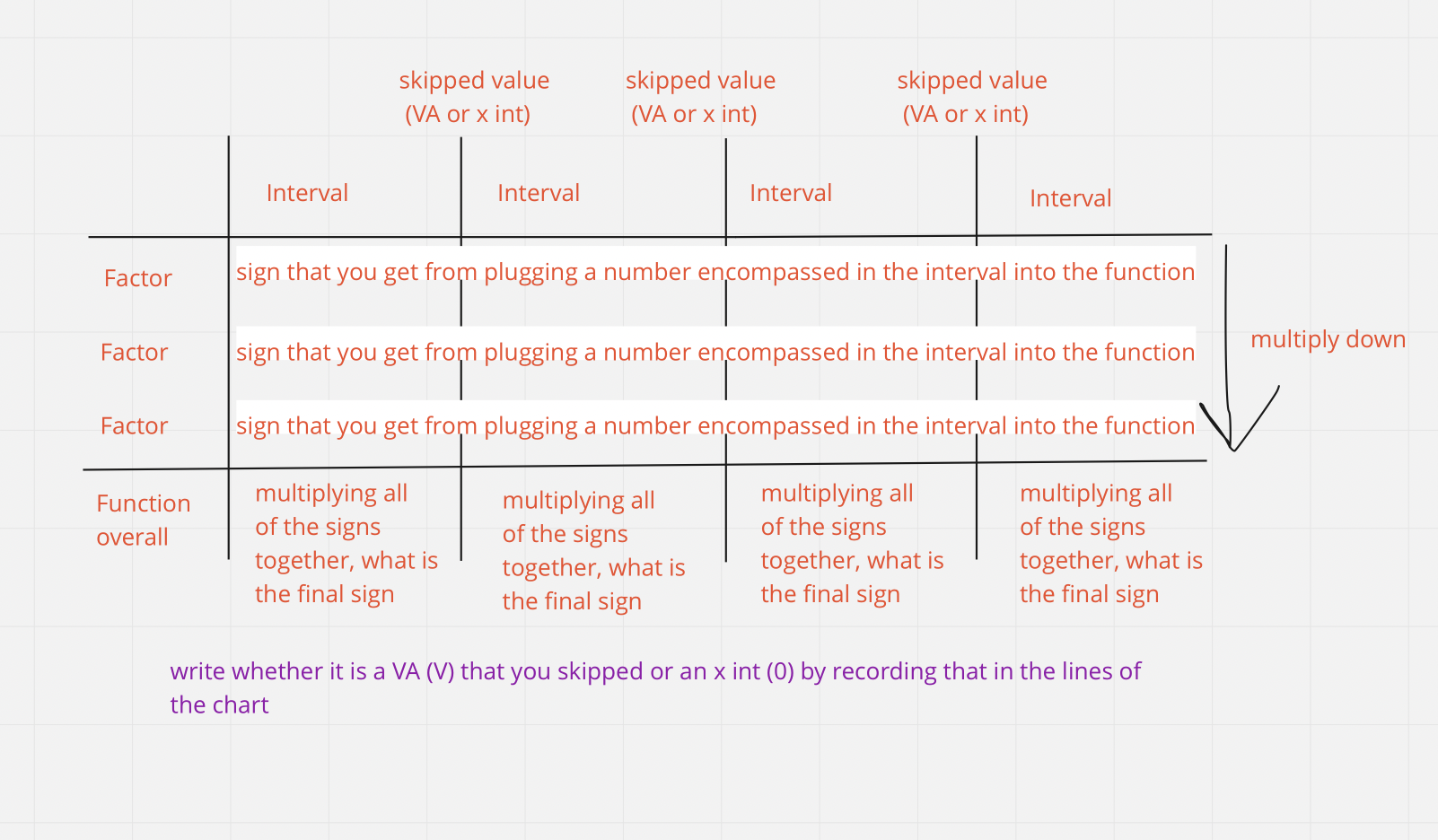
You can get Domain and Range from looking at the original question and seeing where it is positive/negative/positive and equal to 0/negative and equal to 0 from the interval table
Look back to the original question and see what it is asking - then use the interval table to determine what is appropriate for the question
Special Cases
Holes
Degree of the numerator is greater than the degree of the denominator
Always factor where you can
Cancelled terms are what create holes
Restrict (make = to 0) the term that you’re cancelling - this is the x value of your hole’s coordinate → to find the y value of your hole, plug x into f(x) and solve
e.g.
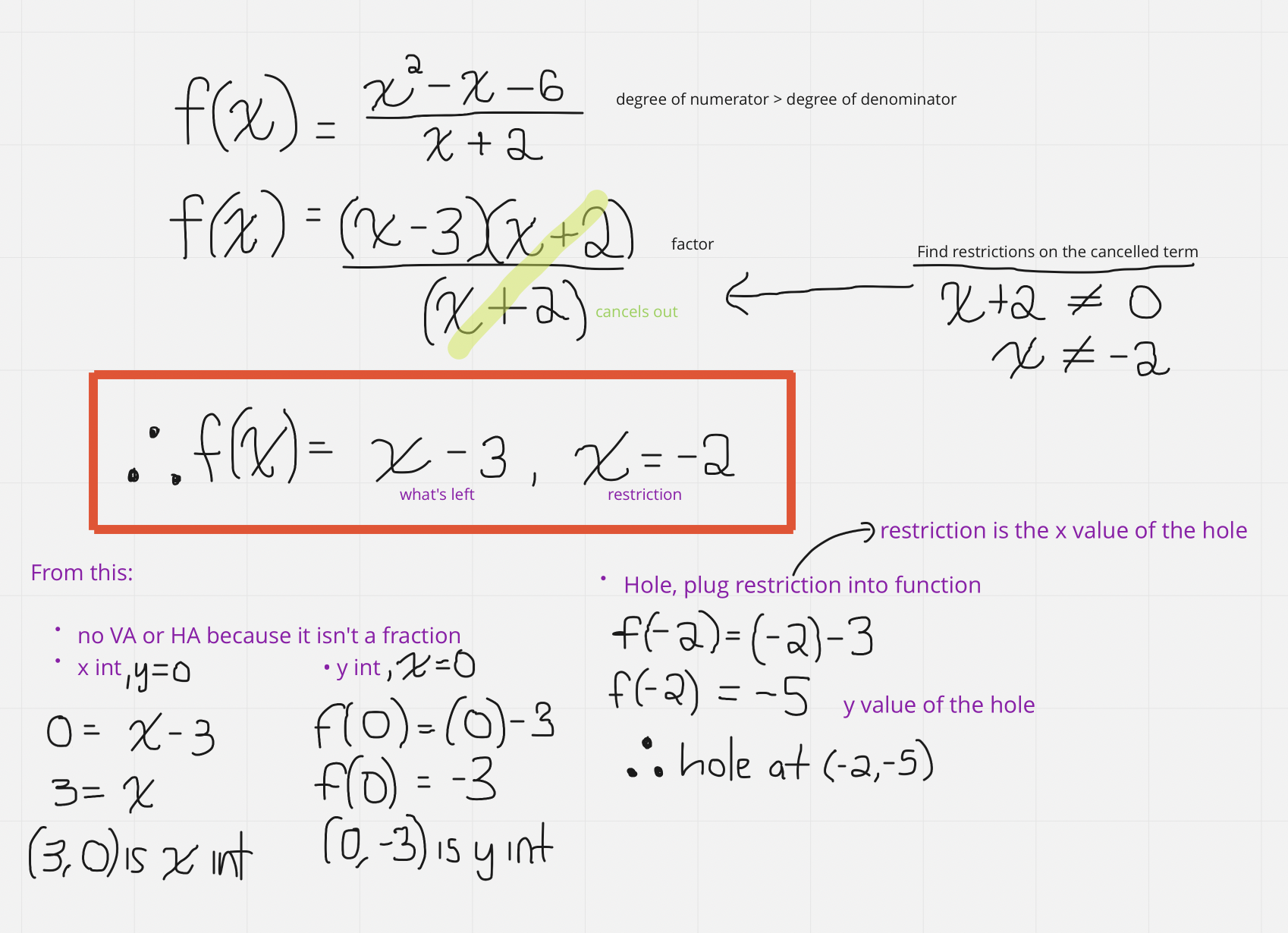
On a graph, holes are shown using an open circle at their point
Oblique Asymptote (OA)
Instead of an HA, essentially a slanted asymptote
Degree of the numerator is greater than the degree of the denominator
Factor - see that nothing cancels and you don’t have a hole
Carry out long division for polynomials
Quotient (minus remainder if applicable) is the OA
y = OA
e.g.
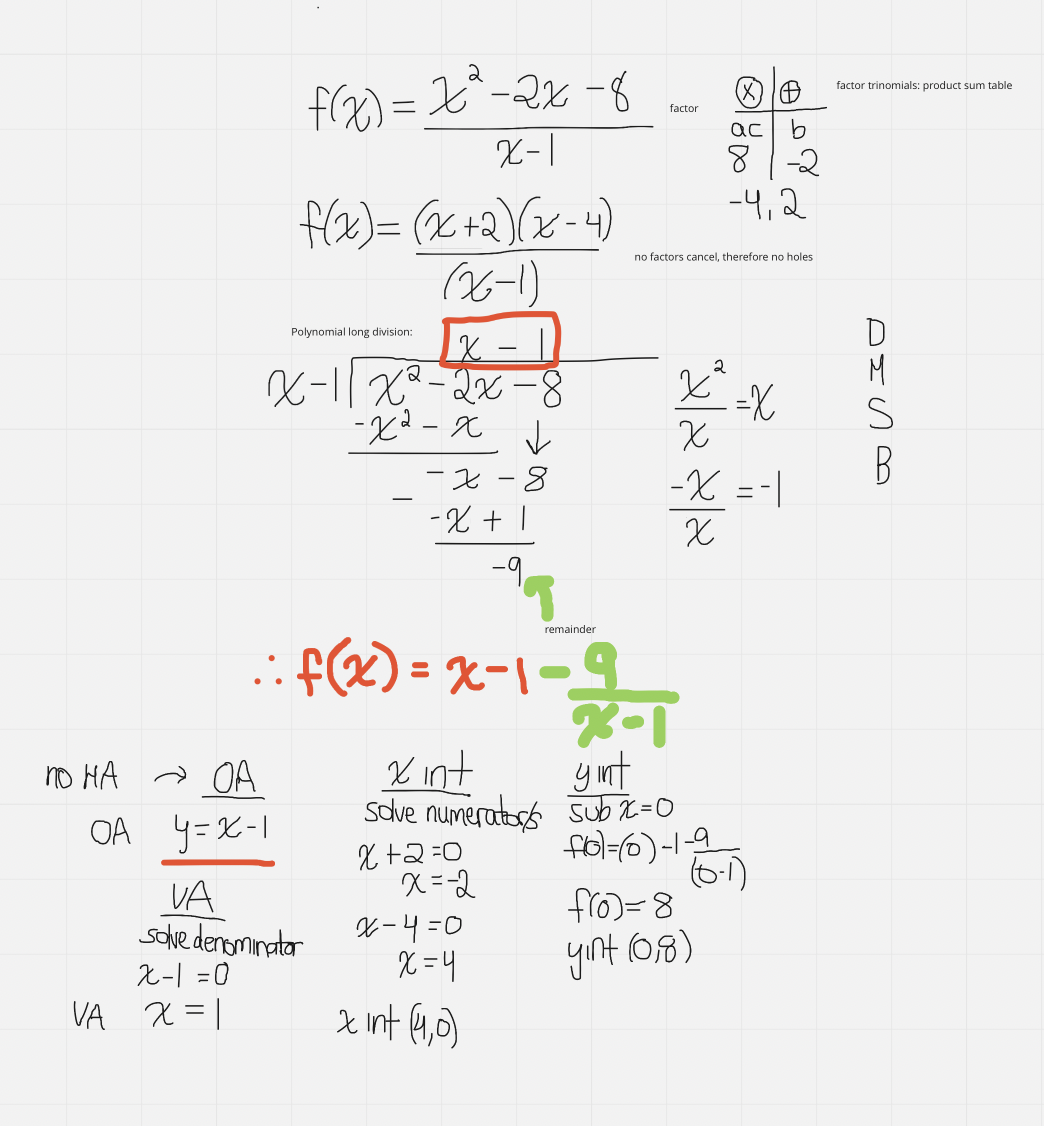
Summary: Asymptote Rules for Rational Functions
VA: Set denominator to 0
HA:
Degree of numerator is less than degree of denominator → HA y=0
Degree of numerator is equal to degree of denominator → HA = y= a/c
OA:
Degree of numerator is greater than degree of denominator → not HA, OA is the quotient of polynomial division
Cancelled terms: make holes